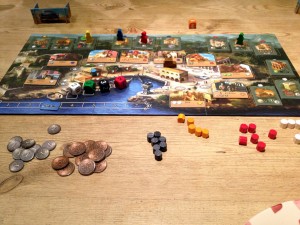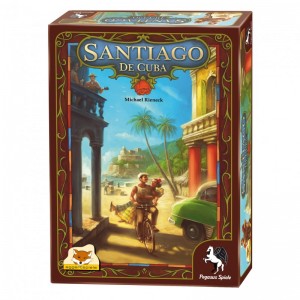Review: Santiago de Cuba
Posted by James (admin) on September 17th, 2012
 There are some designers that seem to be more stealthy than others – you know, the ones that one day you suddenly notice you’ve got a lot of games by them but never realised it as you acquired them. Michael Rieneck is one of those for me – he’s designed games such as Cuba, Havana, Dracula, Fortuna, Palastgeflüster.
There are some designers that seem to be more stealthy than others – you know, the ones that one day you suddenly notice you’ve got a lot of games by them but never realised it as you acquired them. Michael Rieneck is one of those for me – he’s designed games such as Cuba, Havana, Dracula, Fortuna, Palastgeflüster.
Santiago de Cuba is a hard game to fit into a single genre because it mixes several elements together and does so well. Players earn Victory Points (VPs) by delivering goods (tobacco, sugar, citrus fruit, rum and cigars) to the waiting ship, and the player with the most VPs at the end wins. The board shows a port town with a ring of 9 different Cuban characters and the dock as well. On their turn, a player moves the car piece clockwise around this ring – moving one space forwards is free, but costs 1 peso (cash) for every extra space after that.
Wherever the player stops the car, they get to use the Cuban at that space and then get to use one of the buildings associated with that Cuban; however, it is more clever than it sounds. Most Cubans allow the player to do things like gain resources (tobacco, sugar, citrus fruit, wood), VPs and pesos. Each Cuban has one of 4 coloured roses on their tile too – once the player has used the Cuban’s ability, they must move their playing piece to a building that has the same coloured rose (and that is not occupied by another player). The player can then use that building’s ability such as make rum and cigars from sugar and tobacco, exchange goods, convert rum and cigars into VPs, turn one ship’s demand dice to zero, reduce/extend the time the ship will stay (which dictates the value of any goods delivered), and more.
Interestingly, 3 of 12 buildings are randomly assigned to each of the coloured roses at the start of each game, so the buildings associated with each Cuban (and the mix of buildings at each colour) changes every game.
When a player stops the car on the port, players take turns delivering one type of good each to the waiting ship earning 2, 3 or 4 VPs for each good delivered (depending upon how long the ship has been there). Demand for goods is set by dice (one coloured dice matching each of the 5 goods) but only 4 of the 5 dice are present on each ship. The player who triggers the departure of a ship (and so the arrival of the next one) gets to choose which 4 dice will be the demand – leaving out the dice matching the good that you know other players have is a good way to annoy them. When the 7th ship departs, the game ends.
 Overall, Santiago de Cuba is a simple game but has lots of great decisions to be made as you need to find ways to make the most out of the resources you have available. So, finding synergies from using mixtures of buildings and Cubans is critical, but you can’t reply on the building you want being available (as someone else might be there) or rely on a specific Cuban as someone else may use it before you making it too expensive to pay to move onto it. I really like the variety in replay with the order of the Cubans changing every game as well as the buildings which they are connected too as well – in fact, I noticed that buildings that were well-used in one game were less important in others usually because of the way they were paired with different Cubans.
Overall, Santiago de Cuba is a simple game but has lots of great decisions to be made as you need to find ways to make the most out of the resources you have available. So, finding synergies from using mixtures of buildings and Cubans is critical, but you can’t reply on the building you want being available (as someone else might be there) or rely on a specific Cuban as someone else may use it before you making it too expensive to pay to move onto it. I really like the variety in replay with the order of the Cubans changing every game as well as the buildings which they are connected too as well – in fact, I noticed that buildings that were well-used in one game were less important in others usually because of the way they were paired with different Cubans.
Also, one Cuban lets players own a building of their choice for which they get 1 VP if another player uses the building – this is a mechanic used in other games but Santiago de Cuba is a tight game so that giving another player 1 VP (especially in a 2 player game) makes you really think twice about it.
The rondel-like track that is central to the game is simple, works well and cleverly does several things: it gives the player a choice about what they can do that turn but the player can pay cash to override it to some extent, it gives the players some interaction by allowing them to use a Cuban they think another player wants to use, and provides a clear countdown to when goods may be shipped but that’s still ultimately determined by the players because it’s up to them if they stop the car on the port.
Success also hinges in timing your supply with the demand (especially as goods are in limited supply too). Interaction is delivered by players moving into buildings (as that blocks others), moving the car, delivering goods, choosing when to stop the car at the port, and picking the dice for each new ship. They’re not directly confrontational but there’s plenty of mischief to be had upsetting the plans of other players.
The only real criticism I have is that in 2-player games, it’s easy for the same patterns to repeat each round as one player moves the car to the Cuban that works well with their strategy and buildings, and then the other player moves to the obvious choice for themself from there too. With more players, it feels more varied and harder for a player to monopolise a specific Cuban. However, it is still fun to play in 2-player – I just wonder if there should be something that breaks things up a bit like a Cuban moving places or something, or buildings switching colour.
I have to admit that I’m not a fan of Rieneck’s game, Cuba (as I find it too unforgiving); however, I like many other games by Rieneck and Santiago de Cuba is definitely one of them.
In the end, Santiago de Cuba uses some interesting game mechanics to deliver a great game which takes a relatively short amount of time to play. There is a great feeling of interaction and, most importantly, there are lots of tough decisions to make, especially as it feels there are often usually several routes by which you might achieve your goal.
James.
[Played with 2 and 4 players]

